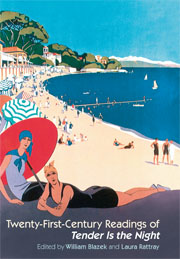Book contents
- Frontmatter
- Contents
- Acknowledgements
- List of Illustrations
- Introduction
- 1 ‘Can't We Put it in Writing?’: Some Short Precursors to Tender Is the Night
- 2 Tender Is the Night, ‘Jazzmania’, and the Ellingson Matricide
- 3 Sanatorium Society: The ‘Good’ Place in Tender Is the Night
- 4 ‘Some Fault in the Plan’: Fitzgerald's Critique of Psychiatry in Tender Is the Night
- 5 An ‘Unblinding of Eyes’: The Narrative Vision of Tender Is the Night
- 6 Si le soleil ne revenait pas: Swiss Clockwork Gone Mad in Tender Is the Night
- 7 ‘A Unity Less Conventional But Not Less Serviceable’: A Narratological History of Tender Is the Night
- 8 American Riviera: Style and Expatriation in Tender Is the Night
- 9 ‘Out Upon the Mongolian Plain’: Fitzgerald's Racial and Ethnic Cross-Identifying in Tender Is the Night
- 10 Gender Anxiety: The Unresolved Dialectic of Fitzgerald's Writing
- 11 Tender Is the Night and the Calculus of Modern War
- 12 Reading Fitzgerald Reading Keats
- Notes on Contributors
- Index
10 - Gender Anxiety: The Unresolved Dialectic of Fitzgerald's Writing
- Frontmatter
- Contents
- Acknowledgements
- List of Illustrations
- Introduction
- 1 ‘Can't We Put it in Writing?’: Some Short Precursors to Tender Is the Night
- 2 Tender Is the Night, ‘Jazzmania’, and the Ellingson Matricide
- 3 Sanatorium Society: The ‘Good’ Place in Tender Is the Night
- 4 ‘Some Fault in the Plan’: Fitzgerald's Critique of Psychiatry in Tender Is the Night
- 5 An ‘Unblinding of Eyes’: The Narrative Vision of Tender Is the Night
- 6 Si le soleil ne revenait pas: Swiss Clockwork Gone Mad in Tender Is the Night
- 7 ‘A Unity Less Conventional But Not Less Serviceable’: A Narratological History of Tender Is the Night
- 8 American Riviera: Style and Expatriation in Tender Is the Night
- 9 ‘Out Upon the Mongolian Plain’: Fitzgerald's Racial and Ethnic Cross-Identifying in Tender Is the Night
- 10 Gender Anxiety: The Unresolved Dialectic of Fitzgerald's Writing
- 11 Tender Is the Night and the Calculus of Modern War
- 12 Reading Fitzgerald Reading Keats
- Notes on Contributors
- Index
Summary
I don't know what it is in me or that comes to me when I start to write. I am half feminine – at least my mind is.
(Fitzgerald qtd in Andrew Turnbull)Fitzgerald was the only one of the younger writers who wrote naturally in sentences.
(Gertrude Stein, The Autobiography of Alice B. Toklas)In her essay ‘“Half Feminine”: Modernism and the Politics of Emotion in The Great Gatsby’, Frances Kerr suggests that Fitzgerald ‘asserts masculinity but confesses femininity’, and coins the phrase ‘artistic masculinity’ to describe his unique approach to gender (409). Indeed, ambiguity and ambivalence are key tropes in Fitzgerald's world-view. He famously remarked in The Crack-Up (1936) that ‘the test of a first-rate intelligence is the ability to hold two opposed ideas in the mind at the same time’ (39). While Fitzgerald is still persistently linked to the male writers of his generation, most notably to his literary sparring partner Ernest Hemingway, this essay will contend that Fitzgerald's Woolfian tendency towards androgyny in fact aligns him more closely with female modernists of the period who explore gender as performance. As such, Fitzgerald can be said to be pursuing Hélène Cixous’ ‘ethics of bisexuality’ (Cixous defining bisexuality as ‘the location within oneself of the presence of both sexes, evident and insistent in different ways according to the individual’ [Sellers 41]) well ahead of his time.
Fitzgerald and female modernism
In many respects, Dorothy Richardson is a forerunner to Fitzgerald. Both writers were searching for ‘something really NEW in form, idea, structure’ (Turnbull, Letters 201).
- Type
- Chapter
- Information
- Twenty-First Century Readings of 'Tender is the Night' , pp. 177 - 191Publisher: Liverpool University PressPrint publication year: 2007
- 1
- Cited by

